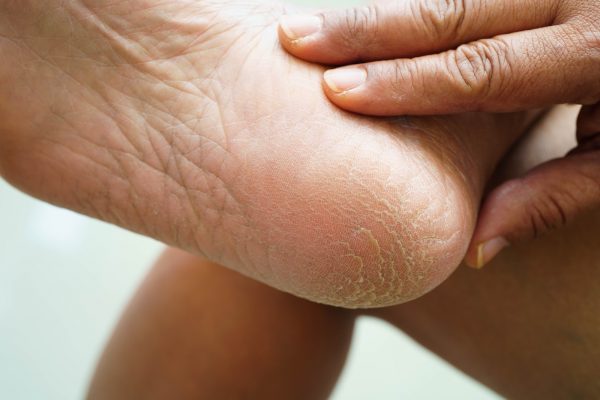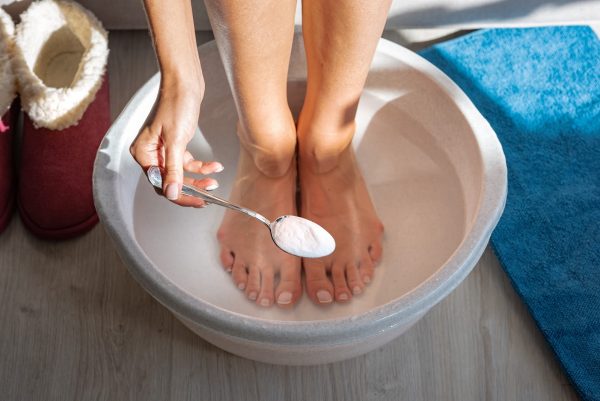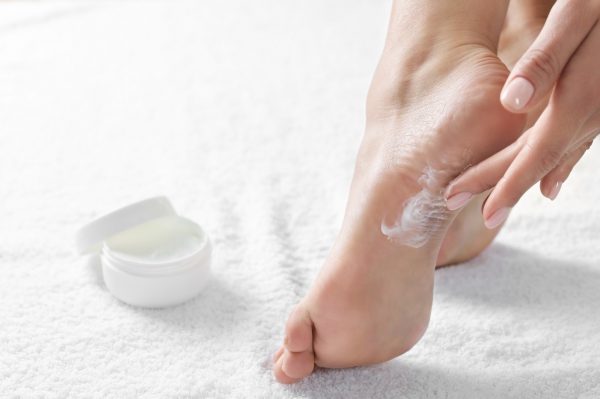You might not be shoveling snow in Fort Myers, but the seasonal shift to drier air and closed shoes still affects your feet. Even though humidity levels in Southwest Florida stay higher than in northern states, the combination of cooler air and constant indoor air conditioning still dries the skin.

This shift, combined with spending more time in closed-toed shoes, can take a surprising toll on your skin. Suddenly, the skin on your heels can feel tight, rough, and itchy. Before you know it, you’re dealing with painful cracks.
Many people dismiss cracked heels as a simple cosmetic nuisance, but they can be much more serious. Those deep fissures, or cracks, are open wounds that can become painful enough to make walking uncomfortable. If left untreated, they can also invite bacteria, leading to a potentially serious infection.
Let’s look at what causes your heels to crack in winter, how to treat them at home, and when it’s time to see a specialist.
What Causes Dry, Cracked Heels in Winter?
The primary culprit for cracked heels is a lack of moisture. During the winter, this is made worse by several factors, even in Florida:
- Drier Air: Lower humidity outdoors and dry, air-conditioned air indoors zap moisture from your skin.
- Hot Showers: While a hot shower might feel great on a cool morning, it strips your skin of its natural oils, leading to dryness.
- Improper Footwear: Shoes that rub or don’t fit properly, or open-backed shoes like sandals and flip-flops, don’t provide any heel support and can allow the fat pad on your heel to expand, increasing the pressure on the skin.
- Prolonged Standing: Spending long hours on your feet, common for active retirees and working professionals, puts continuous stress on your heels.
Even our coveted Florida lifestyle can contribute. Active days on the golf course, long beach walks (where sand exfoliates but salt water dries), or just walking on hard tile floors can stress the skin.
These activities can contribute to heel dryness — especially when combined with factors such as low humidity or insufficient moisturization. This is especially true if you are used to going barefoot, which offers no shock absorption or moisture protection.
At-Home Winter Foot Care for Softer, Healthier Heels
Wondering about the best treatment for dry, cracked heels? For mild cases, it often starts with a consistent at-home foot care routine. The goal is to gently remove the hard skin, then deeply hydrate the new skin beneath.
Here are a few quick foot care wins you can try today:

Soak and Exfoliate
Soak your feet in lukewarm (not hot) water for 10-15 minutes. You can add a little mild soap or Epsom salts. Then, gently pat your feet dry and use a pumice stone or foot file to carefully buff away the thick, callused skin.
Moisturize Daily
Immediately after soaking or showering, apply a thick, heavy-duty moisturizer. Choose a moisturizer for dry, cracked heels with ingredients like urea, salicylic acid, or alpha-hydroxy acids, which help break down hard skin.
Seal it Overnight
For an intensive treatment, apply a generous layer of cream or petroleum jelly at bedtime and wear a pair of breathable cotton socks. This locks in moisture while you sleep.
Hydrate Inside and Out
Supporting your skin’s health starts from within. Be sure to drink plenty of water throughout the day.
Pro Tip: In Florida, it’s easy to underestimate the drying effects of near-constant air conditioning. Even if it’s humid outside, your indoor air is often much drier — especially with air conditioning running. Moisturizing your feet every single day can make all the difference in soothing those feet in winter.
When Dry, Cracked Heels Signal a Bigger Problem
What if you moisturize and exfoliate, but the cracks keep coming back?
Sometimes, dry, cracked heels are not just a surface-level problem. They can be a warning sign of an underlying medical issue that needs professional attention.

Stubborn cracks can be a symptom of:
- Fungal Infections: Conditions like athlete’s foot can cause severe dryness and cracking.
- Skin Conditions: Chronic skin conditions such as foot eczema or psoriasis often manifest on the feet.
- Poor Circulation: Certain conditions, including peripheral artery disease, can reduce blood flow to the feet, making it difficult for skin to stay healthy and heal.
- Diabetes: People with diabetes are especially prone to dry skin. A simple heel crack can cause pain and even lead to health complications if you have diabetes, as nerve damage (neuropathy) may prevent you from feeling it, and reduced circulation can turn it into a non-healing wound or a serious diabetic foot ulcer.
So, when is it time to stop the home remedies and see a podiatrist? Here are the signs:

- The cracks are deep, bleeding, or causing significant pain.
- You see signs of infection, such as redness, swelling, or drainage.
- The cracking persists or gets worse despite consistent at-home care.
- You have diabetes, neuropathy, or a circulatory disorder.
If you’re experiencing any of these, it’s time to stop guessing. These are all clear reasons to see a podiatrist and get a professional diagnosis.
How a Podiatrist Can Help (and Why Local Care Matters)
You don’t have to live with painful, cracked heels. But what is a foot and ankle specialist — also known as a podiatrist — and how do they treat this common problem?

At The Foot & Ankle Group, we provide comprehensive care for all foot and ankle conditions. Our specialists can determine the exact cause of your cracked heels and create a treatment plan for immediate relief and long-term prevention.
Treatments may include:
- Gentle Debridement: A safe and painless in-office procedure to gently remove the hard, dead skin. This provides immediate relief and allows healing to begin.
- Medical-Grade Moisturizers: We can prescribe powerful, prescription-strength creams that are far more effective than over-the-counter options.
- Evaluation for Underlying Issues: We will assess you for biomechanical problems, circulation issues, or infections.
- Custom Orthotics or Footwear Guidance: If your footwear or foot structure is contributing to the problem, we can provide custom solutions.
If you’re nervous about a visit, we make it simple. You can learn exactly what to expect when you visit our office, from check-in to your personalized treatment plan.
With convenient, local offices across Southwest Florida — including Fort Myers, Cape Coral, and Bonita Springs — you don’t have to drive far or wait weeks. Expert foot care is right here in your community.
Winter foot care in Florida is more than just pampering; it’s an essential part of keeping your feet healthy and strong year-round. Don’t wait until a small crack becomes a big problem.Explore our blog for more tips on foot and ankle health, or learn more about our foot care treatments for lasting relief. If dry, cracked heels are keeping you from feeling your best, let our Southwest Florida foot care specialists help you step into comfort this season.
Categorized in: Blog
Comments are closed